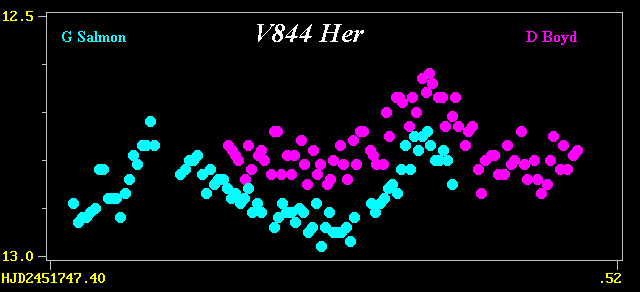Eclipsing Dwarf Novae update September 2000
Bill Worraker
PROGRAMME CHANGES
Stars Dropped:
On advice from Prof. Fred Ringwald that enough photometric observations of
V503 Cyg are available to show that it is non-eclipsing, this star has now
been dropped from the programme.
Photometric data from Lasse Jensen (CBA, Denmark) on T Leo and AY Lyr in
outburst in previous years, together with IBVS 4059 (on AY Lyr) have shown
superhumps in both stars but no sign of eclipses. These stars are therefore
also dropped from the programme as non-eclipsers.
A high-quality 7.6-hour photometric dataset from Tonny Vanmunster (CBA,
Belgium) on RZ LMi shows clear superhumps (a full 5 cycles!), but no sign of
eclipses. Tonny also advises that several detailed photometric studies have
revealed no sign of eclipses. RZ LMi is therefore also dropped from the
programme as a non-eclipser.
Stars Added:
Added this month (September 2000) are AR And, CY Lyr and LL Lyr;
see the latest programme list for details. AR And reaches 11th magnitude
at maximum, while CY Lyr and LL Lyr reach 13th magnitude, so all three
should be relatively easy to reach when in outburst.
THE 2000 JULY SUPEROUTBURST OF V844 HER
On July 17 the SU UMa star V844 Her went into outburst at magnitude 12.2.
This was its first detected outburst since 1999 September 29 when it was
seen by Hazel McGee [see the article by Gary Poyner, VSSC 102, p.5
(1999 December)]. V844 Her has a very short orbital period of 1.32 hours
(estimated from its superhump period), which places it amongst the dwarf
novae with the shortest known periods. Several such stars (e.g. WZ Sge,
HV Vir, LL And) have very long outburst intervals (measured in years to
decades) and only appear to undergo superoutbursts. Thus far V844 Her has
similarly been observed only to undergo superoutbursts, but its outburst
cycle of 260 days is much shorter. It is thus perhaps a unique system.
Photometry with a view to detecting possible eclipse behaviour during the
2000 July outburst was received for 3 nights, July 19/20, 20/21 and 21/22.
Superhumps of about 0.2 mag amplitude were clearly visible on the second
and third nights. The most interesting light curves obtained were for July
21/22, when both Graham Salmon and David Boyd were taking unfiltered CCD
measurements. There was considerable overlap between their data sets,
allowing confirmation of a superhump trough at July 21.960UT and a peak at
21.981UT. Combining Graham Salmon's light curves for the second and third
nights allows the superhump period (assumed stable for at least the
intervening 24 hours) to be estimated as 1.415 hours or 0.059 days, rather
longer than the figure quoted in Gary Poyner's article. The superhumps are
of fairly typical shape, the 'rising' portions of the curves occupying about
half the time taken by the 'falling' portions. See light curve below.
As for eclipse behaviour, none is evident in these light curves. Although
V844 Her will remain on the EDNe programme since we do not yet have coverage
of three complete orbits, it appears unlikely that it is an eclipsing system.

| Photometric Results on V844 Her for 2000 July 21/22: |
|---|
Graham Salmon:
LX200 10" f10 + Norman Walker filter box + SXL8 CCD (unfiltered).
Exposures 60 sec with 15 sec dead time
Data reduction: Average of results from cf with stars 2, 6 and 7 of TA seq.
|
David Boyd:
0.102m refractor + HX15 CCD (unfiltered).
Exposures: 60 sec
Note: Results based on linear fit with corrected magnitudes for reference stars.
|
THE 2000 AUGUST SUPEROUTBURST OF GX CAS
On August 21 Gary Poyner reported the SU UMa-type dwarf nova GX Cas to
be in outburst at visual magnitude 13.7. Nick James obtained a continuous
5.5-hour photometric dataset on the night of August 23/24 (pretty well as long
a run as possible at this time of year!). The resulting light curve is on
The Astronomer
web pages
This light curve shows beautiful superhumps of about 0.3 mag crest-to-trough
amplitude, but no sign of eclipses. Once again, although there is insufficient
data to make a final decision on this star, it appears very unlikely that it is an
eclipsing system.

